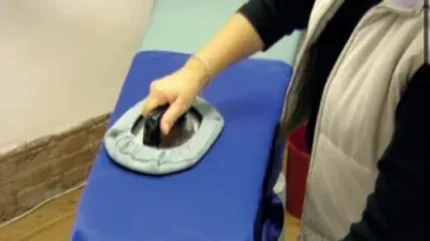
Keeping it clean
Clean, stain-free items can quickly become soiled if the production area and associated equipment is not subject to a regular housekeeping regime. A clean production environment is fundamental to producing clean lint free items, so, at the start of the working day, a quick dust/wipe over of the finishing equipment should form part of a routine procedure which should include scheduled cleaning of floors and the areas above and behind machines. These latter areas are frequently inaccessible and difficult to keep free from lint and debris, to this end a light blow over at reduced pressure with a compressed air line, on a weekly basis will enable high standards to be maintained over a long period with very little effort. While I do admit this involves redistributing lint and particulates into the working area, done with care on a weekly basis, this is absolutely minimal.
Health and safety
The build up on equipment, pipework and horizontal surfaces of lint from cotton, linen and viscose items presents a considerable fire hazard; once ignited this type of dust will, in seconds , spread the fire around the contaminated areas leaving staff very little time to respond before the fire gets out of control. Staff also need to regularly check and clean the dust filters on tumbler dryers and all types of automated finishers and also the air intakes on electric motors. In the past there have been many serious fires caused by contaminated equipment overheating.
Finishing aids
Frequently ignored and often in poor condition or missing, if used correctly finishing aids support good production rates, and without doubt reduce the amount of time and effort needed to produce high standards of finish.
A typical range of finishing aids would include – these may take different forms
- Finishers wooden block
- Trowel / mock iron
- Rod type tie former
- Pleating band
- Brushes soft and hard
- Sleeve expanders
- Vent clamps
- Curved body clamps + T clamps for trouser bottoms
- Press mitt (alternative to a trowel)
Various types of finishing aid can frequently be found behind presses and ironing tables covered in dust and in pretty poor condition after going missing or being discarded. This is a good indicator that staff are in need of training as skilled well trained finishing staff would consider all the above items indispensable.
Over recent years due to their ease of use and standards of sleeve finish, sleeve plugs have become increasingly popular. However, they are frequently inserted too far into the end of the sleeve reducing the standard of finish towards the cuff. The synthetic foam inside the plugs has a limited lifespan and is expensive to replace but they can be cheaply renewed using supermarket synthetic foam sponges.
Another useful tool is a dog comb which can be used for restoring tangled/matted fur fabrics and sheepskin rugs.
Preparation
Preparation refers to the use of finishing aids in conjunction with the operation of automated finishing equipment. It is important that former covers are replaced when worn or if holes develop. In particular, holes will allow steam and air to bleed off during operation which can seriously affect standards of finish.
If you are to get the best out of all types of automated finishers it is essential that staff position and adjust garments and finishing aids correctly and that the following are observed.
Shoulder supports are adjusted as appropriate for various garment sizes. Sleeve expanders / plugs are correctly positioned. Trouser zips are closed and waistband tensioners released when using trouser toppers. Timer settings are adjusted where appropriate – for example increased for a heavy coat.
Finally, all types of well clothed and maintained finishing equipment in the control of well trained staff will pay very real dividends in terms of quality and production rates.






